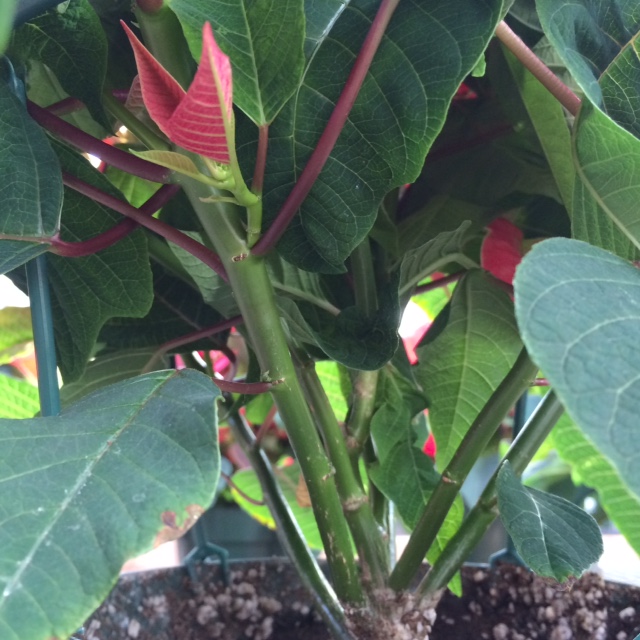
Millions of poinsettias are purchased each year during the Christmas season by people who enjoy the color and warmth they provide to their home. Healthy plants will last throughout the holiday season. How do you choose the perfect poinsettia? Poinsettia plants should be stocky with dark green foliage, well-formed richly colored bracts (modified leaves) and very few open flowers (golden-yellow clusters located at the center of the bracts.) Proper selection will help to insure a long lasting plant that you will enjoy throughout the holiday season.


There are few tricks to get your poinsettia home safely. If temperatures are below 50° F, the plant must be sleeved to protect the plant as it leaves the warmth of the garden center. Avoid exposing poinsettias to cold temperatures. A chilled plant will begin to drop leaves very quickly. Once inside, remove the protective wrapping. It is often easier to carefully slit the side of the sleeve to remove it. Because poinsettia bracts are a little sticky and can adhere to plant sleeves, pulling them down will result in branches breaking. Don’t leave them wrapped for more than the time it takes to get your plant home. Leaving them covered can result in blackening, curling and overall plant distress. If you plan to give the plant as a gift at a later time, ask for a second plant sleeve to use when you transport it to its final destination.
Contrary to popular belief, the Poinsettia is not likely to harm your pets or your children. Research at Ohio State University, working with The Society of American Florists, has proven that no toxicity was evident at experimental levels that would well exceed the amounts likely to be ingested in the home environment. Were a person to consume a great many leaves, the result would likely be mild stomach upset. The white sap can cause skin irritation which can be remedied by washing with soap and water.
How to care for your Poinsettia
• TEMPERATURE: A cool room (65-70F during the day and 60-65F at night) is ideal. Avoid hot or cold drafts or excess heat from appliances, fireplaces, radiators or ventilating ducts.

• LIGHT: Very bright, indirect light is essential for proper growth and color retention.
• WATER: Plants should be checked daily and watered thoroughly whenever the soil feels dry to touch or the pot becomes light. If the plant is wrapped in foil, slit the bottom to avoid water accumulating at the bottom of the pot. If it is in a basket, be sure to discard any drainage that collects. Poinsettias hate to have their pots standing in water and they aren’t very forgiving about it.
• FERTILIZER: Plants should be fertilized with a well-balanced all purpose fertilizer like Peter’s 20-20-20 until the poinsettia is in full color. Once in full color, reduce fertilizing to ½ strength once every 3-4 times that you water.
Reflowering Your Poinsettia
If you have a gardener’s green thumb, you may want to try your hand at reflowering your poinsettia next year. If you follow these directions very carefully, it is possible to have your poinsettia in flower by Christmas. The following describes the cycle of poinsettia color.
• December: Full bloom. Water as needed.
• Late March to Early April: Color fades. Keep near a sunny window. Cut stems back to about 8”. Water as needed and fertilize with a well-balanced, all purpose fertilizer like Peter’s All-Purpose Plant Food. Around May you should see new growth.
• June 1st: Re-pot if necessary in a well-drained potting mix. You can put your plant outside if you would like as long as the night temperatures are consistently above 55 F and it is protected from the hot sun.
• July-August: Pruning may be required to keep your plant compact and bushy. Do not prune after September 1st.
• Starting October 1st: Provide complete and continuous darkness for 12-14 hours night combined with 6-8 hours of bright light a day. During the night, stray light of any kind, streetlights or household lamps, may delay or halt the re-flowering process.
• Remember: The key to success is to follow the strict light-dark requirements very carefully.
• Once your poinsettia is in full color, stop fertilizing until it loses its color and the cycle starts again in March.
Poinsettia Facts
The assigned botanical name is Euphorbia pulcherrima, meaning “the most beautiful Euphorbia”. The United States’ first ambassador to Mexico, Joel Robert Poinsett, sent several plants back to his home in Greenville, South Carolina in 1825. The common name, poinsettia, comes from his last name.